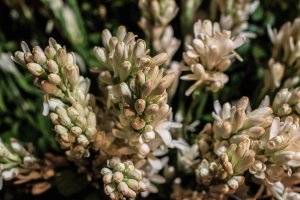Tuberose is a popular floral note in perfumery known for its rich, heady scent. It adds depth and complexity to fragrances, often used in oriental (amber) and floral compositions. It is sweet, heady, and intoxicating with notes of jasmine and orange blossom. Our perfumers dive deep into this luxurious romantic scent and provide some of our most-recently composed tuberose-infused fragrances.
Historians believe that the origins of tuberose lie in ancient Mexico where it is said the Aztecs used its precious essential oil to intensify the flavor of their chocolate.
In the 16th century, it reached the shores of Europe with the Spanish conquest of Mexico. Exotic, rich and narcotic, tuberose requires a warm, dry climate and it is found in southern India, Egypt, Morocco, The Comoros, Italy, Spain, the south of France in Grasse and Tunisia.
Tuberose is a fragile flower with five petals that bloom in clusters and is planted in a straight line with bulbs placed exactly 15 centimeters apart.

There are 20 snowy white flowers per spike and they reach out to be about 3 feet high. Growing tuberose is labor-intensive, as it is a process that requires daily maintenance and a great deal of weeding.
Harvested from May to December with peak time in August, these blooms are hand-picked each morning as all of the petals of the flower (the corolla) open. It takes 1,000 plants to yield an average of 30kgs (60 pounds) to 40 kgs (about 80 pounds) of flowers.
Tuberose production has increased notably since the 19th century. Once used to decorate funeral altars in parts of Asia, in India, its name means night fragrance.
Here it is found in many festivals, religious rituals and particularly in weddings, where its intoxicating charm is infused in personal adornments, bouquets and garlands that decorate the bedrooms of newly weds.
In Hawaii, brides wear tuberose blossom leis on their wedding day.
In the United States, it is a highly prized ingredient in some of Alpha Aromatics’ most beautiful and sophisticated perfume formulations.
What Does Tuberose Smell Like?
Tuberose is a multi-faceted scent marked by tinges of sweet honey and rich, ambrosial white blooms.
Feminine in character, it releases a narcotic stream of elements that can have green and earthy accents or almond-like aspects.
Some say that the fragrance is a mystical blend of salt, and somewhat sugary coconut and vanilla-nuanced creme brûlée.
The most popular varieties of tuberose that are used include: Mexican Everblooming, a type of single flower and the Pearl, which features double flowers.
It is a glorious fragrance with many interpretations, and a versatility that derives from its many volatile compounds, which makes it an ideal choice for our perfume masters at Alpha Aromatics to use in both custom perfumes and scented products.
Lactones emit fruity, sweet and milky facets and its unique, wild aroma symbolizes all flowers and all women.
Which Fragrances Go Well With Tuberose?
Master perfumers know how to tame tuberose with soft, round notes so that they can be used to create white floral accords for feminine fragrances.

These feature facets that include: narcotic jasmine, bright, fruity agarwood; sweet, floral ambrette; soft, woody amyris; spicy, floral bergamot and other citrus oils; creamy gardenia, buttery magnolia, light bitter neroli, fiery, floral carnation; earthy, dry carrot; warm, honeyed cassis; sweet orange blossom; warm, aromatic clary sage and luscious, rich frangipani.
Tuberose is opulent but it can also be very sensual and carnal. It essential oil is is usually found in heart notes but its is so potent that is is often used in dry downs as well.
A Few Fascinating Facts About Tuberose
Tuberose Is Known By Many Names
This bloom is also known as: Indian Hyacinth; Madonna Lily; Omixochitl (Aztec); Polianthes tuberose; Vara de San Jose (Staff of St Joseph), the corporal flower, harlot of perfumery, Rajanighanda; (India) and Sedan Malam (Indonesia), both names of which translate into “aromatic at night.”
Tuberose is Symbolic In The Victorian Language of Flowers
In the unspoken Victorian language of flowers, when tuberose is offered in autumn, it signifies insatiable love, lust and passion. Young women were taught to avoid its smell as it bloomed in family gardens in the hopes of keeping them free from sexual urges and desires.
Queen Maria Antoinette Popularized Tuberose In 18th Century France
This French queen popularized the use of tuberose in perfumery and had two scents created for her named Sillage de la Reine and Parfum de Trianon. The former was a combination of tuberose, jasmine, sandalwood, cedar, Iris and orange bloom.
Tuberose In The Most Fragrant Stem In The Plant Kingdom
The master perfumers at Alpha Aromatics appreciate tuberose as a flower that has the distinction of retaining its fragrance up to 48 hours after it is cut. It also is known to come alive at night.
Louis XIV Loved Tuberose
During his reign (1638-1715), this king perfumed the corridors of Versailles and his gardeners brought in 10,000 tuberose bulbs for the Trianon sugar plantations.
Tuberose Is A City Flower
From one of its monikers, Polianthes tuberose, derives the meaning of the Greek words for city; namely, polis and anthos, meaning flower. These reflect the love of tuberose in ancient times as perfumed decorations for terraces, verandas, window sills and balconies.
Tuberose Is A Commercial Crop That Is Not Found In The Wild
Tuberose is known as a cultigen, which refers to any plant species that does not grow in the wild and has been deliberately altered by humans. Many modern tuberose scents flourish within the walls of laboratories, but it is a commercial crop in both France and India.
Tuberose Absolute Is Among The Most Prized And Costly In The World
It requires more than a ton of flowers to produce less than half a pound of tuberose absolute. A single ounce costs north of $600!
There Are Two ‘First’ Descriptions of Tuberose
In 1753, two descriptions of tuberose emerged. One was Polianthes tuberosa by Carl Linnaeus and the other was Tuberosa amica by Friedrich Kasimir. Today, these are both considered the same species.
The Use Of Tuberose In Scented Products
A potent floral source, the perfumers at Alpha Aromatics often produce tuberose for use in personal care products including hand and body lotions and soaps.
It is known to emit a milky, rich white flower bouquet streaming with aspects like: intense and narcotic jasmine, sweet orange blossom, creamy gardenia, buttery magnolia, light, floral neroli, bright lily and floral, complex and lush frangipani.
The regenerative powers of tuberose help to slow down signs of aging, soothe breakouts, deter inflammation and maintain healthy skin.
A Few Of Our Recently-Composed Fragrances
The following Alpha Aromatics fragrances represent the power of tuberose as a heart note that ignites both energy and intensity to all the other facets in any formulation.

Black Leather Coriander
This bold fragrance opens with a daring burst of citrus. Facets of clean, fresh and light bergamot, acerbic lime and juicy orange.
These elements soon morph into a smooth heart note featuring pervasive, refreshing coriander, grassy, green tea, soothing, mellow lavender and waxy, exciting tuberose.
A dry down of dark, rich and warm amber, dry, somber cedar, soft, sensuous leather and lush, noble vanilla concludes this scent.
Galbanum Bloom
This intriguing fragrance opens with top notes of dark, sugary and berry-like cassis melded with succulent orange and fresh, clean lemon.
These facets gently drift into a floral heart note marked by elements of rich, narcotic jasmine, cloudy, fluffy and vanilla-nuanced heliotrope, waxy, exciting and buttery tuberose, honeyed, sugary and spicy freesia, and heady, warm honeysuckle.
The scent completes with a dry down featuring elements of green, woody and balsamic galbanum and fiery, fruity clove.
Labdanum Tuberose
This delightful fruity/floral blend opens with top notes marked by succulent, honeyed mandarin, sugary, green and fiery strawberry and fresh, crunchy and sweet juniper berry.
These facets soon fold into a heart note featuring facets of powdery violet, rich, narcotic jasmine, light, pleasing neroli, exciting, creamy tuberose and floral, sugary and erotic ylang yang.
A dry down of dark, honeyed amber, sugary, floral cocoa, deep, potent labdanum and lush vanilla complete this scent.
Rosewood Nectarine
Streaming aspects of sweet, fresh bergamot and apricot-tinged nectarine open this unforgettable fragrance.
A fragrant heart note soon follows characterized by facets of rich, floral, and jasmine-nuanced ylang ylang, powdery, woody orris root, sweet, floral rosewood and waxy, creamy tuberose.
An ultimate dry down of woody, buttery sandalwood, dark, masculine patchouli, passionate musk and dry, earthy and green oak moss completes this beguiling fragrance.
Radiant Currant & Amber
This memorable scent opens with a rush of intense citrus facets of juicy, sugary mandarin, and tart, uplifting grapefruit melded with tangy black currant.
These aspects soon drift seamlessly into a middle note bursting with tropical, waxy and bright lily, intoxicating jasmine and creamy, exciting and waxy tuberose.
A dry down of dark, warm and golden amber, sensual, potent patchouli, passionate musk and lush, noble vanilla completes this fragrance.
In Conclusion
If you are developing a new product line or seeking a customized signature fragrance of any kind, particularly one including the fragrant aroma of tuberose, contact our teams at Alpha Aromatics today.
We’re always here to help!

Photo Credits: Pixabay
 alpha aromatics®
alpha aromatics®